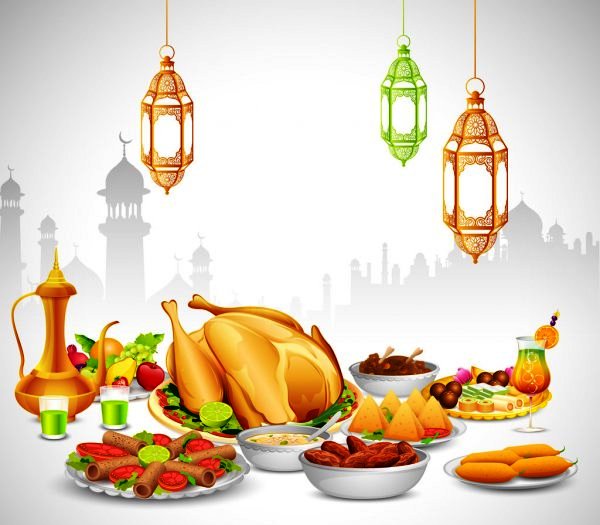Traditional food of Ramadan

Family and friends gather to enjoy Iftar
Food is part of Ramadan’s traditions; family and friends gather to share and enjoy the two meals that are served: Iftar celebrated at sunset when Muslims break their fast, and Suhoor consumed early in the morning before the day starts. Fasting has an important role in teaching patience, compassion and gratitude. It also reminds people about those suffering from poverty and hunger.
A traditional Iftar menu includes a variety of dishes. But whether an Iftar is simple or big, sharing food with the needy during this holy month is an important aspect of the feast and Muslims are encouraged to help the poor.
Muslims break their fast three dates
At the end of the day, family members gather around Iftar table and wait for the Maghreb Adhan that marks the end of the fast.
- Muslims break their fast by eating 1 or 3 dates as was the practice of Prophet Mohammed who broke his fast with three dates and water. From a nutritional point of view, dates are an excellent source of fibers, natural sugar, iron and magnesium. They help restoring blood sugar after long hours of fasting.
Soups are a delicious and healthy option to start the Iftar
- Soups are very healthy options to start the Iftar as they replenish the body fluids and warm the stomach, hence preparing it to receive other foods. Lentil, vegetable, chicken, and vermicelli soups are usually served during Ramadan, with lentil soup being the most common one in Lebanon.
Refreshing jallab topped with nut seeds (Source: http://whatson.ae/)
- Refreshing juices like Jallab, Amar al-Din and Tamarind are very commonly consumed either before or after the meal to replace fluids lost during the day.
It is advised to eat slowly after fasting the whole day. Eating quickly after being deprived of it for an entire day, may result in indigestion and other gastric problems. Liquids like juices and soups allow the stomach some time to process and ensure proper functioning.
Fattoush remains the king of salads!
- Fresh vegetables are a must-have for Iftar as they are a very important source of fibers, vitamins and minerals needed after a long day without food. They also help in reducing bloating and constipation which are common problems among fasting people. Fattoush is Ramadan’s star! It is loaded with a rich combination of fresh vegetables and topped with fried or baked bread. Olive oil and pomegranate molasses are usually used for the dressing.
It is very important to drink 8 glasses of water to hydrate the body, and better distribute them in small quantities between Iftar and Suhoor to avoid bloating. Better avoid salty and spicy food which increase thirst, and consume more fresh vegetables and fruits.
- A traditional Lebanese Iftar gathers delicious main courses – such as stews, stuffed vegetables (Mehchi Koussa and stuffed vine leaves), Moulouhkiyeh, Rez aa djeij, kebbeh bel siniyeh and many others – which provide a balance of starchy foods, vegetables and proteins (meat/ chicken/ fish/dairy products/ beans). A number of side dishes or mezze such as cheese rolls, fatayer, sambousek, hummus b tahineh, etc. are also usually served.
Traditional food is served: baked kebbeh, stuffed vegetables etc.
- Ramadan is renowned for the variety of Sweets prepared and consumed during this holy Month to satisfy the post Iftar sweet cravings. However, Kellaj remain the star of Ramadan sweets as it is exclusively prepared during this time of the year. Dried fruits such as apricots, figs, raisins and prunes are also commonly eaten after Iftar; they are healthy options rich in fibers and nutrients.
Arabic sweets are not to be missed during Ramadan
Sweets are hard to resist in Ramadan. Be moderate in your consumption and opt for small portions!
Suhoor, the pre-dawn meal, is consumed early in the morning before Fajr prayer. The Musaharati or Tabbal walking around the streets while beating a drum and calling “Ya Nayem Wahed Al Dayem” (which means “Awake faster and praise Allah…”) calls people to wake up for the Suhoor. This old tradition goes back to the Ottoman era and is still practiced nowadays in Lebanon.
A healthy Suhoor is important to provide enough energy for those who are fasting and help them endure up to 15 hours.
A healthy Suhoor is important to provide enough energy for those who are fasting and help them endure up to 15 hours. Water should also be consumed during Suhoor to keep the body hydrated during the day.
A variety of delicious and healthy foods are offered for Suhoor such as Manakeesh, eggs and omelets, dairy products like labneh and cheese, “foul mdammas” fava beans, fruits and vegetables etc. Meshtah bread is commonly baked and consumed during Ramadan; its recipe varies among Lebanese villages. Meshtah is flat bread that was originally prepared in the South of Lebanon and became very common to other Lebanese regions. It is made with jreesh (cracked wheat that has not been parboiled) or bulgur and is sprinkled with sesame and Nigella seeds. It is also slightly aromatized with anise flavor. During Ramadan, Meshtah is usually enjoyed freshly baked on Suhoor with Labneh or cheese and a cup of tea.

Leave a Reply